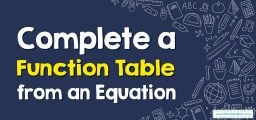Discontinuous Function
A function in algebra is a discontinuous function if it is not a continuous function. A discontinuous function has breaks/gaps on its graph. In this step-by-step guide, you will learn about defining a discontinuous function and its types.

The diagram of a discontinuous function cannot be made with a single stroke of the pen, which means we put the pen down to draw the graph of a discontinuous function, we must pick it up at least once before the graph is complete.
Related Topics
A step-by-step guide to a discontinuous function
A discontinuous function is a function in algebra that has a point at which either the function is not defined at that point or the left and right-hand limits of the function are equal but not equal to the value of the function at that point or the limit of the function does not exist at the given point.
A discontinuous function has gaps along with its graph. In other words, if it is not a continuous function, it is called a discontinuous function. Discontinuous functions have holes or jump in their graphs.
Discontinuous function definition
A function \(f\) is said to be a discontinuous function at a point \(x = a\) in the following cases:
- The left-hand limit and right-hand limit of the function at \(x = a\) exist but are not equal.
- The left-hand limit and right-hand limit of the function at \(x = a\) exist and are equal but are not equal to \(f(a)\).
- \(f(a)\) is not defined.
Discontinuous function graph
The diagram of a discontinuous function cannot be made with a pen without lifting the pen. To draw a graph of a function that is discontinuous, when we put the pen down to draw the graph, we must pick it up at least once before completing the graph and then continue drawing again.
A discontinuous function has breaks or gaps on its curve. Therefore, the range of a discontinuous function has at least one gap. We can identify a discontinuous function through its diagram by identifying where the diagram is broken and has a hole or a jump.
Types of a discontinuous function
The different types of discontinuities of a function are:
- Removable discontinuity:
For a function f, if the limit \(lim _{x\to a}\:f\left(x\right)\) exists (i.e., \(lim_{x\to a^-}\:f\left(x\right)=lim_ {x\to a^+}\:f\left(x\right)\)) but it is not equal to \(f(a)\). It is called removable discontinuity.
- Jump discontinuity:
For a function f, if the left-hand limit \(lim _{x\to a^-}\:f\left(x\right)\) and right-hand limit \(lim _{x\to a^+}\:f\left(x\right)\) exist but they are not equal. Hence, the limit if the function \(f\) does not exist. Then, \(x = a\) is called jump discontinuity (or) non-removable discontinuity.
- Essential Discontinuity:
The values of one or both of the limits \(lim _{x\to a^-}\:f\left(x\right)\) and \(lim _{x\to a^+}\:f\left(x\right)\) is \(\pm \:∞\). It is called infinite discontinuity or essential discontinuity. One of the two left-hand and right-hand limits can also not exist in such discontinuity.
Discontinuous Function – Example 1:
Identify whether the function \(f(x) = \frac{(x – 3)}{(x – 6)}\) is a discontinuous function.
Solution:
The function \(f(x) = \frac{(x – 3)}{(x – 6)}\) is not defined at \(x = 6\). So, it is discontinuous at \(x = 6\).
Exercises for Discontinuous Function
Find the point of discontinuity of each function.
- \(\color{blue}{f(x)=\frac{x^2-4x-21}{x+3}}\)
- \(\color{blue}{f(x)=\frac{x^2-x-2}{x^2-5x-6}}\)
- \(\color{blue}{f(x)=\frac{2x+3x^2+x^3}{x^2-x}}\)
- \(\color{blue}{f\left(x\right)=\frac{\sqrt{x^2+5}}{x+5}}\)

- \(\color{blue}{x=-3}\)
- \(\color{blue}{x=-1, 6}\)
- \(\color{blue}{x=0 , 1}\)
- \(\color{blue}{x=-5}\)
Related to This Article
More math articles
- How to Graph Quadratic Functions? (+FREE Worksheet!)
- Top 10 6th Grade Common Core Math Practice Questions
- How to Find the Volume of Cones and Pyramids? (+FREE Worksheet!)
- How to Represent Systems of Linear Equations Using Matrices?
- How is the GED Math Scored?
- Using Number Lines to Compare and Order Rational Numbers
- How Is Math Use in Solar Energy?
- Discover the Solutions: “ASTB Math for Beginners” Complete Solution Manual
- 3rd Grade MCAS Math Practice Test Questions
- Full-Length SSAT Upper Level Practice Test-Answers and Explanations


























What people say about "Discontinuous Function - Effortless Math: We Help Students Learn to LOVE Mathematics"?
No one replied yet.